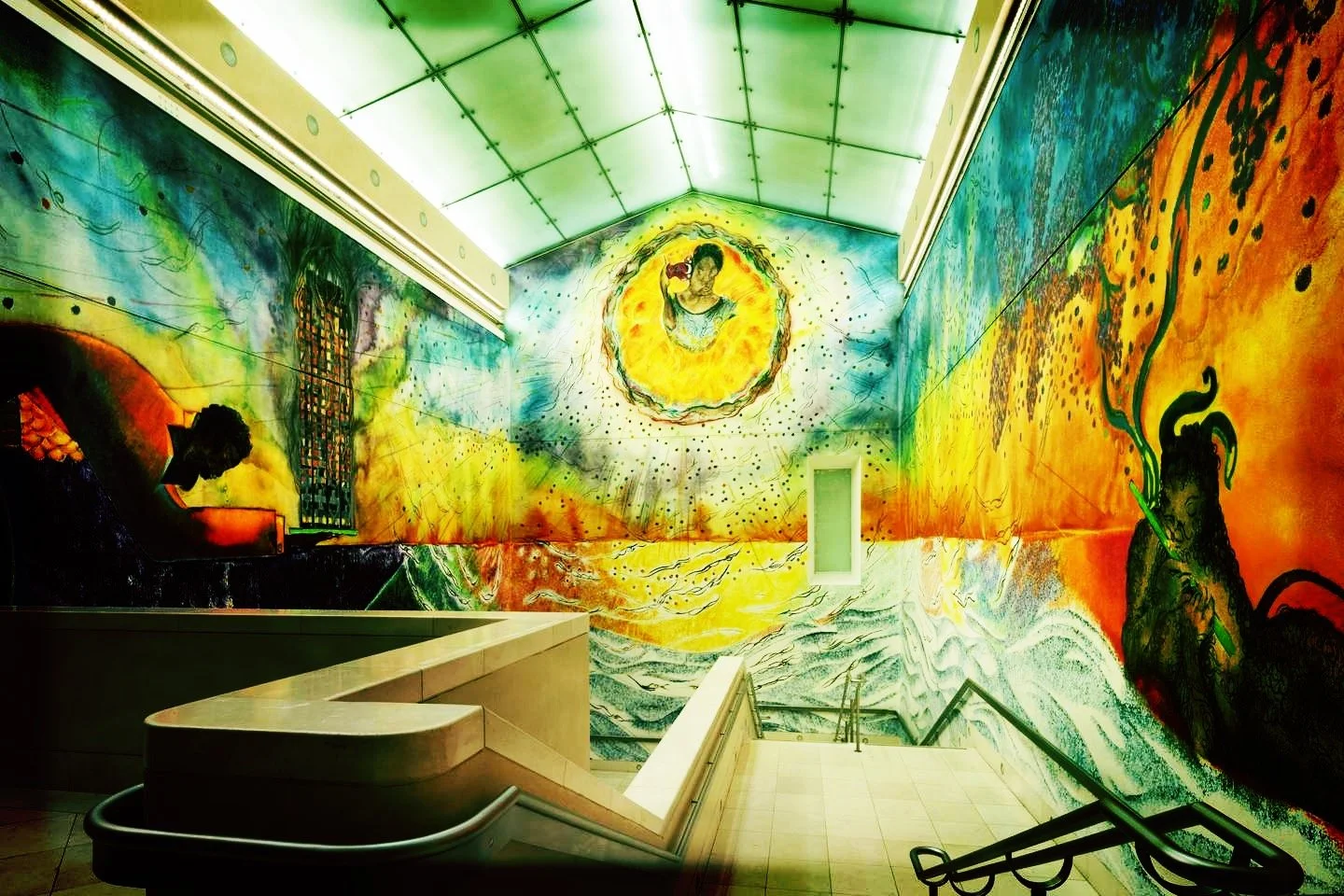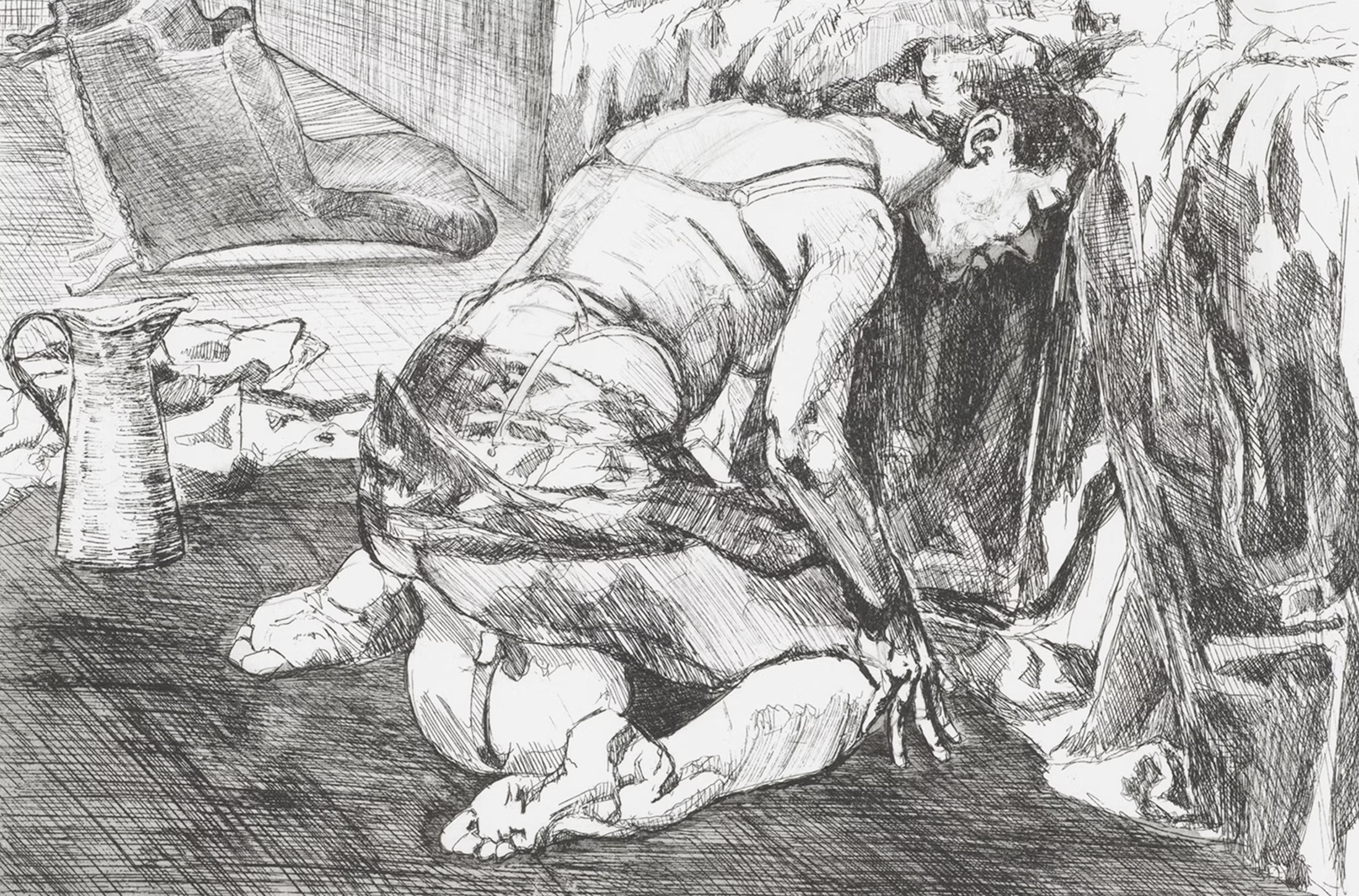Cover Image Ofili C, Requiem (2023)
The desire to tell stories is a strong one for many of us; whether told around a table of friends, sung, written down, visualised in two or three dimensions or shown at the cinema.
Look briefly at the work of at least two of the following artists and consider their place as practitioners working with narrative in a historical context.
Narrative art stirs an uneasy feeling. Here come the narrators! A wave of foreboding, you prepare yourself to be unsettled. But luckily we have Chris Ofili. He can shake things up, but he delivers his subjects with a song in his heart. That ranges from a sophisticated Jazz composition to a haunting sea shanti. So we feel enlightened and improved rather than mentally assaulted. Which is, in the most respectful way, a good introduction for Paula Rego.
Rego, a highly skilled representational artist. One look at the work and I feel the darkness descending. Rego matches Ofili with the box ticking – personal, historical, political, significant, gender…….but her approach is unapologetic. Not to say Chris Ofili’s is apologetic, but visually one artist is clearly more affronting than the other.
PAULA REGO
I chose to wade right in with Paula Rego. And look at her illegal abortion series. The pastels and the etchings. Technically both artists chose materials considerately and their choices add agency to their work. Although Rego avoids depicting graphic detail she has a Hitchcock way of delivering the charge of the subject matter. The density of her etchings and cropped compositions confine the viewer within the scenes and prompt a visceral response to the suffering of those women and girls.
Fig.1 Rego P, Untitled 5 (1999)
CHRIS OFILI
Subjects that bare the weight of history and conflict are often unyielding in their delivery. And if the subject is sensitive in content it is complicated to explore through discourse.
Chris Ofili’s approach to his chosen subject matter is generous in it’s range of existential narrative. Avoiding polemical expression, along with the style of his art – playful, informed, vibrant, he engages with the audience with great impact. Void of contention there is space to learn and remember. To align with your own nature and acknowledge the stories within the art.
Ofili’s paintings investigate identity, aesthetics, and culture that amalgamate abstraction and figuration. Famously using a range of mixed media and techniques in his work, it is informative and illuminating.
He has successfully manifested his own personal path between continents and experiences into an encyclopaedia of global events and memoirs.
Requiem is a large scale installation in Britains Tate gallery. It is a tribute to the victims of the Grenfell Tower Fire. It encompasses all the points relating to the study of narrative art.
The process of creating such a monumental piece of art drew on an personal experience. Practically, elements from paintings Ofili had previously made. And personally, feelings from the experience, having to confront and qualify the tragedy.
Manifesting a seismic event already places it in the political and cultural arena, but due to his style and characterisation it provides a place for the victims, facts, and for the memories to reside. As Ofili said in the 2023 interview with the Guardian, “It’s important at times to use skill and platform to say something that’s beyond words, really. I think this is beyond words. You can’t talk for 10 years. But somebody can look at something and have their own personal responses in 10 years’ time.” (Ofili 2023).
Fig.2 Ofili C, Requiem (2023)
CONCLUSION
It is interesting to see how the production and choice of materials effect the viewers experience. Rego’s style is immediate. Perhaps this immediacy reacts like a disappearing message. They can be so reactive that our mind protects itself from holding onto that visual for long periods of time. It can be called upon in moments of discussion or other such necessity. But we also turn away from it to avoid scarring our minds eye. Pointedly in the same way that Chris Ofili averted his eyes from the Grenfell site multiple times before forcing himself to confront and embed that scene for the process of making “Requiem”.
Ofili’s style is allowed to linger and the content of his narrations turn over in the mind with the pace of an interesting book. Taking a place in the library our our thoughts.
It is not to say one has more power than the other. Reading the resources on both artists they are fully aware of how they present their work to the world. It is a notable point of cause and effect which you can utilise in creating art, or observing.
List of Images
Cover Image Ofili, C (2023) Requiem, photo edited with Hipstamatic. [Fresco] At:https://www.tate.org.uk/whats-on/tate-britain/chris-ofili-requiemAccessed (25.05.2025).
Fig.1 Rego, P. (1999) Untitled 5. [Etching on Somerset paper] At:https://www.metmuseum.org/perspectives/the-deeply-political-art-of-paula-rego Accessed (25.05.2025).
Fig.2 Ofili, C (2023) Requiem. [Fresco] At:https://www.tate.org.uk/whats-on/tate-britain/chris-ofili-requiem Accessed (25.05.2025).
Bibliography
Farrell, J (2024) The Deeply Political Art Of Paula Rego. At:https://www.metmuseum.org/perspectives/the-deeply-political-art-of-paula-rego (Accessed 26.05.2025).
Younge, G. (2023) Chris Ofili on his epic, three-wall Grenfell Fresco. At:https://www.theguardian.com/artanddesign/2023/sep/12/chris-ofili-grenfell-fresco-requiem-tate-britain (Accessed 26.05.2025).
Artsy. (2025) Chris Ofili. At:https://www.artsy.net/artist/chris-ofili (Accessed 26.05.2025).

